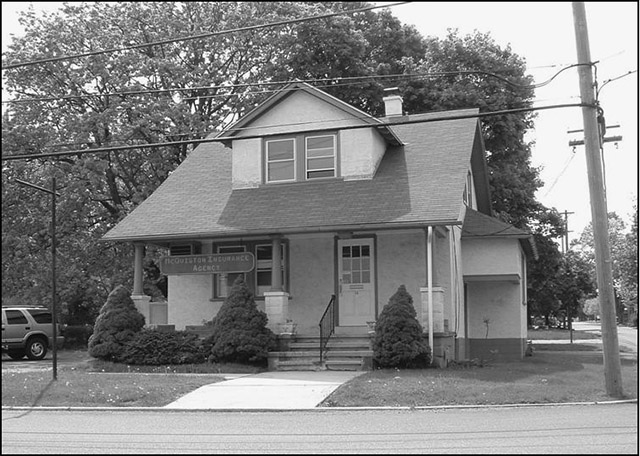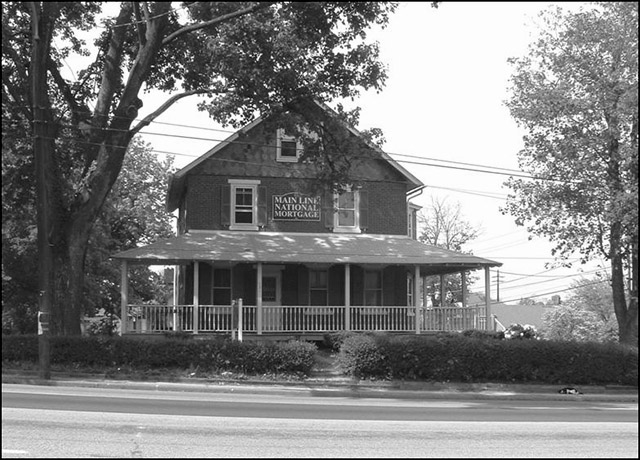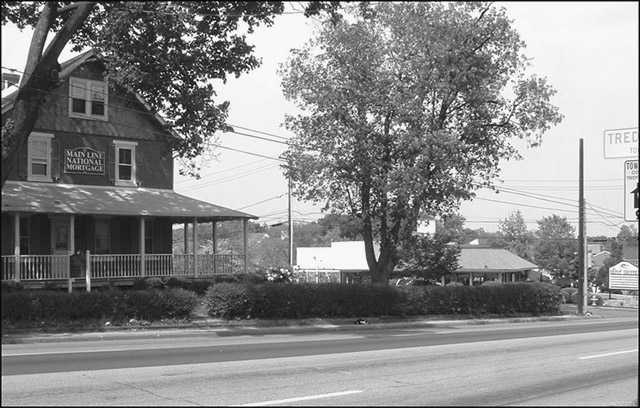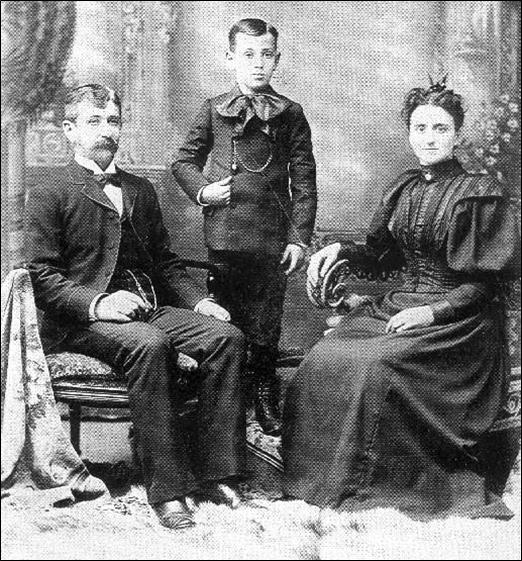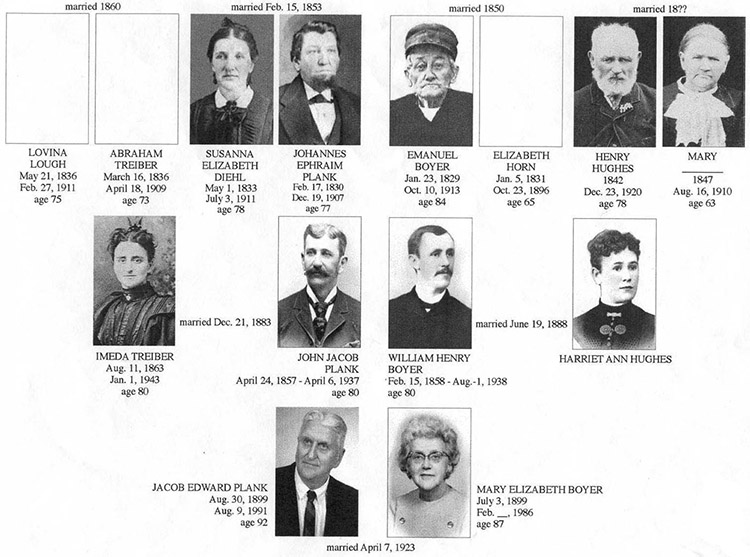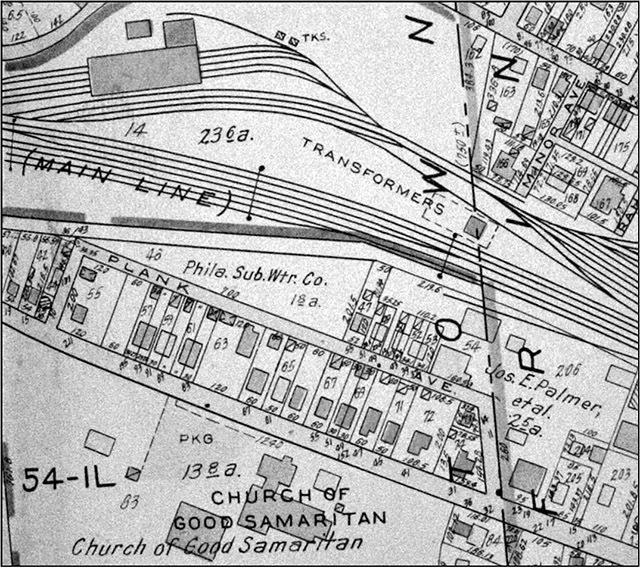|
Home : Quarterly Archives : Volume 43 |
||||||||||||
Tredyffrin Easttown Historical Society |
||||||||||||
|
Source: Fall 2006 Volume 43 Number 4, Pages 112–118 The Plank Family and Plank Avenue of Paoli
Editor's note—In the summer of 2006 three houses next to Plank Avenue in Paoli were demolished to make way for a new Commerce Bank that opened on the site on September 30, 2006. Two of the 3 houses belonged to the Plank family. Bonnie Haughey (BH) of the McQuiston Insurance Agency and Joyce Post (JP), editor of the Quarterly, interviewed Gerald Schneider (GS), husband of Patricia Plank, on June 16, 2006 at the new location of the McQuiston Agency, which by then had moved to the Depot Shoppes in Paoli at 31 Plank Avenue. Previous to this move, the McQuiston Agency was located in the Plank's Cape Cod house.
The Plank Cape Cod house formerly at the southwest corner of Plank Avenue where it makes a sharp turn to the west. Photograph by Joyce A. Post, May 2006. GS: I'm sorry to hear they're going to tear down the little Cape Cod previously situated on the southwest corner of Plank Avenue where it turns left before going into the Depot Shoppes, and formerly occupied by the McQuiston Insurance Agency. I lived in the big Victorian house on the corner of Plank Avenue and Route 30. I'm married to a Plank. My wife is Patricia Evelyn Plank (b. 5-25-1937). But none of the Planks are interested in history. I became interested in genealogy when I became a grandfather. I set out to identify all the great grandparents' last names—that's 16 families—on both sides. One of my wife's brothers, Robert Edward Plank (b. 2-24-1931), had a box of papers from their mother and he had never opened the box. There was an old family bible and papers and letters and photos.
Above: The Plank Victorian house formerly at the
northwest corner of Plank Avenue and Route 30.
The builder of the former red brick Victorian house on the northwest corner of Route 30 and Plank Avenue that was most recently occupied by Main Line Mortgage, was John Jacob Plank (b. 4-24-1857; d. 4-6-1937). He was sent here from Gettysburg to open the Paoli Railroad yard. He was to set up the Paoli service center for the Pennsylvania Railroad. He started what eventually became that superfund site there in the rail yard and had the house built in approximately 1890. 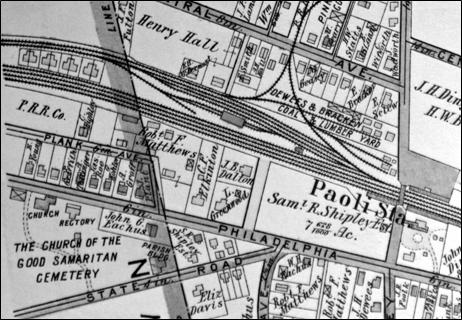
Plank Avenue is at the middle of the left edge and then sharply angles down to what was at the time was called the Philadelphia & Lancaster Pike. The Planks built their houses in the angular plot between these 2 roads. The Paoli Pennsylvania Railroad yards are near the middle. The Robert F. Matthews lumber yard lies between the angle of Plank Avenue and the railroad yards. From plate 9, Part of Tredyffrin Twp., of the 1912 Atlas of the Properties on the Main Line Pennsylvania Railroad ... published in Philadelphia by A. H. Mueller. John Jacob Plank was born in Gettysburg, where the Planks were from. He went to work for the railroad and his progression led him here to Paoli. There's railroad in the Plank blood. My wife still jumps in the car with the dog and goes down to the tracks in West Grove to see the train go by when she hears the whistle blow. John Jacob Plank and his wife, Imeda Treiber (b. 8-11-1863; d. 1-1-1943), had 2 children. The first child, Harry Ephraim Plank (b. 4-4-1886; d. 12-5-1897), died at age 11 in Paoli. The cause of death was from a common childhood illness of the time. I have the obituary clipping and a picture of him. Two years later John Jacob's 2nd child and my future father-in-law, Jacob Edward Plank (b. 8-30-1899; d. 8-9-1991), was born. He went by the name of Ed. When my father-in-law married Mary Elizabeth Boyer (b. 7-3-1899; d. 2-?-1986) in 1923, John Jacob Plank had the little Cape Cod house built for them.
John Jacob and Imeda Treiber Plank and their son Harry Ephraim. My wife, Patricia Evelyn Plank, is the 8th of the 9 children of Jacob Edward Plank and Mary Elizabeth Boyer. One died young, but there were 8 children living in the little Cape Cod and Grandmother Plank—Imeda—was living alone in the big brick Victorian house. She was a reclusive lady. I think losing her first son made her distant. When Patricia and I were married in 1958 at Paoli Presbyterian Church we lived in West Chester for a year. Then we had our first child. We came to Paoli and I built an apartment on the second and third floors of the Victorian house. My grandfather, Joe Ferrier, a builder from West Chester, came to visit us one day and as he pulled into the driveway, he looked over and said, “I built that Cape Cod house.” It turned out my wife's grandfather hired my grandfather to build the house that she was raised in. We stayed in the Victorian house until we had a few kids and then moved out on our own. Imeda was not there then. When she died in 1943 and everyone moved into the big house, they sold the little Cape Cod house.
*There is a discrepancy in the death date of Johannes Ephraim Plank. The Plank name is German. I traced the family back to the great-grandfather of John Jacob Plank, Conrad Plank (b. 9-10-1765; d. 1-20-1842). In 1790 Conrad Plank married Anna Maria Schlebach (b. 1-16-1771; d. 9-10-1859). They had 13 children. Their 3rd child was John Plank (b. 1-26-1795; d. 4-8-1875). In 1819 John Plank married Annie Catherine Saltzgiver (b. 11-21-1800; d. 5-9-1879). They had 11 children. Their 5th child was Johannes Ephraim Plank (b. 2-17-1830; d. 12-10-1907). In 1853 Johannes Ephraim Plank married Susanna Elizabeth Diehl (b. 5-1-1833; d. 7-3-1911). They had 9 children. Their 4th child was John Jacob Plank. I don't know how Conrad Plank came to arrive in America. Most of this information came from York and Gettysburg. We got cemetery records and we had the family bible with a lot of good information. This gave us a start for going to the historical societies to search for more information. Unfortunately, I couldn't interview anybody. And I couldn't find any newspaper articles. On my side of the family, I found some good newspaper stories about some of the older people. Like my grandfather who built the Plank's Cape Cod house. None of my family—either my wife's or my side—are from Chester County. They've all migrated here. My mother's side came from Johnstown and my dad came from Delaware. I've had to travel for everything that I've gotten. The Ferrier name was a pretty big name out in western Pennsylvania. One ancestor was a riverboat pilot, another was a captain in the Revolutionary War and two of his sons served in his company. I'm a baseball fan and historian and I go to the Baseball Hall of Fame in Cooperstown, NY every other year. We were looking at the plaques there one day, looking for Mike Schmidt, and we found an Eddie Plank, “the Gettysburg Kid.” He pitched for the Philadelphia A's in the early 1900s. He's a distant relation; he and John Jacob Plank were first cousins. We're guessing that Jacob Edward's middle name came from that connection. He went by Ed Plank. Everyone in Paoli knew Ed Plank. He was also a railroad guy. He followed in his father's footsteps and worked for the railroad too. He was in charge of all the switches from Coatesville to City Line. We visited a cemetery up near Hanover, PA ; there are a lot of Planks in that cemetery. John Jacob and Imeda Plank are both buried at Upper Bermudian Church, Adams County, with their first son, Harry Ephraim Plank. It's a tiny little country church; an old church. They went back to their home town to bury the child. It was the Plank family cemetery. It's not far from Gettysburg. My daughter married a man from Carlisle, the son of the local undertaker in Carlisle. He chose not to join his father in that business and now he's the Vice President of Marketing at Unisys in Blue Ball. And Bob Plank, my wife's older brother also worked for Unisys. Earlier he had worked at Burroughs as an engineer; before it merged with Sperry to form Unisys. He was down in “the valley” at Swedesford and Cedar Hollow Roads, where there is still a Unisys operation. BH: I always wondered how Plank Avenue was named. Before you told us about the railroad connection, I thought maybe they were farmers and that this area was the Plank family farm. Did they do any farming? GS: No. I'm not sure how John Jacob Plank came to buy the land and what things looked like at the time. The Planks donated the land for the road and that is why it is named Plank Avenue. The short one-block-long section is Plank Avenue. When it dog-legs to the west, it becomes Plank Road. Or at least it did. The Victorian house actually had a Lancaster Avenue address: 131 W. Lancaster Avenue. This block is a substantial part of Paoli. My father-in-law was injured in a railroad accident in the late ‘50s; maybe the early ‘60s. He was badly burned on his legs and spent a couple of months in Bryn Mawr Hospital. Something in the railroad yard went awry. He was able to work again for a few more years after that, but he was near retirement when that happened. He lived until the age of 92. They used to have family gardens where the Philadelphia Curling Club now is further up on Plank Avenue. The produce was just for the families; they didn't sell any of it. When my wife was a kid, all the children had to work in the gardens and pull weeds. That was in the late ‘40s and early ‘50s. Those gardens stayed there until they built the curling club. My father-in-law had a garden there when we were living here. Everybody had their plot. Like a community garden. Plank Avenue is the township line. On the west is Willistown, on the east is Tredyffrin. All my wife's family went to Tredyffrin/Easttown High School in Berwyn. It was T/E before it was Conestoga. It was before they built Great Valley High School. I went to West Chester High School. It was T/E when we played them in football. That was our traditional Thanksgiving game: the West Chester/Berwyn rivalry. All the Planks graduated from T/E High School. I have Jacob Edward's graduation picture from T/E.
BH: What do you know about the Boyer side of the family? GS: My mother-in-law, Mrs. Jacob Edward Plank, Mary Elizabeth Boyer, was born and raised in Mahanoy City, in the coal country, up near Pottsville. We knew some history of her. There was never any correspondence with John Jacob's family, once he broke away from Gettysburg and since Jacob Edward was the only child, there were no more relations. My wife never knew any cousins or relatives on the Plank side from Gettysburg. Her maternal grandmother was Harriet Ann Hughes, (dates not available). My wife's mother's grandfather, Emanuel Boyer (b. 1-23-1829; d. 10-10-1913) was the founder and first mayor of Mahanoy City. In 1850 he married Elizabeth Horn (b. 1-5-1831; d. 10-23-1896). Harriet Ann Hughes came over from Wales as an indentured servant, married the mayor's son, William Henry Boyer (b. 2-15-1858; d. 8-1-1938), moved up the social ladder, and sent her daughter, Mary Elizabeth Boyer—my mother-in-law—to college. She went to Kutztown, became a teacher, and taught over here at Greentree School in Willistown. There is no connection between my wife's mother's family and the Boyers who may have founded Boyertown. Mahanoy City is not near Boyertown. I used to work in Boyertown and I knew the Boyers of Boyertown, including the chairman of the Boyertown Bank. It's not the Boyertown Bank anymore, of course.
GS: The Robert F. Matthews lumber yard stood on the site of today's Paoli Depot Shoppes when my wife lived here. In fact, we were living in the apartment in the Victorian house when the lumber yard caught fire in the early ‘60s. It was in the wee hours of the morning. It woke us up. We got up and looked out the window. The sky was orange. We weren't afraid. We heard the fire trucks coming. The houses along Plank Road were in more danger than we were. It was a big fire; a big event. After that, they built the Ansel Chemical Company back here. I think they made fire extinguishers. The Ansel Chemical Company property got converted to the Depot Shoppes. I don't know if any of the original buildings are now a part of the present Depot Shoppes. It could be. There was also a lawnmower shop back there somewhere. My father-in-law used to help out with the lawnmowers. Clark may have been the name of the lawnmower shop.
GS: The Palmers—Joe Sr., Joe Jr., and Linda Davis—were a major construction company and, along with Arlington Supplee and the Dalton Brothers, built a lot of the houses on the former Biddle estate in this area of Paoli. The Palmers are the current landlords of the McQuiston Insurance Agency. They owned the Plank's Cape Cod house when it was sold to Commerce Bank for their new branch office. Joe, Sr. wanted very much to buy the brick Victorian house for years. Just to develop it, I guess. Our family held onto it until just two or three years ago. We were renting to Weichert Realtors—Andy Wilson's firm. When Andy left, next came a chiropractor and then a psychiatrist. Bob Plank managed the property for the family and took care of it. When we lost Patsy's two older siblings, we decided to sell. I think it was a dentist who bought it from us.
This 1963 map (Plate 13, Tredyffrin & Willistown Twps.) from the Franklin Survey Property Atlas of the Main Line, Penna. Volume Two ... shows Plank Avenue and the Plank property, the expansion of the railroad yards, and Jos. E. Palmer et al as the owner of the Depot Shoppes area. BH: Did you know John Giantonio and the Giantonio Realtors? Al McQuiston, of the McQuiston Insurance Agency—and my father—has never been more than 2 or 3 blocks from the train station. He never wanted to be more than two blocks away from the center of Paoli. He did not want to own office space. He started in business in 1957 by selling homeowners insurance policies to the clients of the realtors at Giantonio Realtors. At that time, their office was in the space now occupied by Starbucks Coffee. John Giantonio was his first business partner and a silent partner after dad went out on his own in 1959. We rented from the Giantonios until they went out of business. By then my father had purchased the Pete Preston Agency and Joseph Palmer, Sr. was one of Pete's clients. So we started renting from the Palmers. The last place we rented from the Giantonio's was space in the 209 Building. For some reason, unknown to me, each time the Plank cottage came up for rent, Joe, Sr., tried to persuade our father to sign a lease. We finally did in 1989 and stayed there for 15 years. My brother and I kept up our campaign to purchase office space but the Plank Cape Cod was not for sale. Likewise, for a long time, Joe, Sr., wanted to purchase the Plank Victorian house.
GS: I actually went curling at the Philadelphia Curling Club one time. Somehow, I met up with a man who was in charge of the club, through one of the schools our children were in so we were invited to come curling. My father-in-law, Jacob Edward Plank, was involved. Not as a curler, but he spent time there and they all liked him. He had retired by then and liked to “hang out” there. He didn't have anything to do with it being established there, even though it was built on his garden. He just got to know the people as they were building it and became the local curling fan. Everyone knew him. In fact, the headmaster of education at the Church Farm School and his wife were involved in the curling club, and it was through him that my wife and I came to spend an evening there, learning how to curl. But that was the only time I tried it. I didn't take to the game like I did to golf. [For a history of the Philadelphia Curling Club see “Curling in Paoli: The Philadelphia Curling Club,” by Len and Mary Gottliebsen, Tredyffrin Easttown History Club Quarterly, Vol. 32 No. 2 (April 1994), pp. 59-66.] Jacob Edward Plank went to the Tel-Hai Nursing Home probably around 1985. Mary Elizabeth, his wife, lived at the family homestead for a year after, until she was involved in a car accident. She and her daughter-in-law, Lori, were in a car when it got hit by a state highway truck pushing a snowplow down where Chesterbrook Blvd. comes out onto Swedesford Road. Somehow the snowplow plowed into the car. She was in great health and might have lived for another twenty or thirty years. She was a neat lady. She'd go anywhere any time. When we'd call and say, “We're taking a trip. Do you want to go?” she'd say, “I'll be ready in 10 minutes.” The new sanctuary for the Church of the Good Samaritan on the south side of Route 30 was built, I think, when we were living in the Victorian house. I started coming here in 1957 when my wife and I started dating. I was here a lot then. There was never anything else there; it was all open. They didn't tear anything down to build the sanctuary.
JP: You've told us many things and the interconnectivity of all it is what impresses me. It sounds like everybody knew everybody else and that's fascinating. GS: In those days, that's the way life was in small towns. Everybody knew everybody. I think that's one of the problems today in a town like West Chester, for example. It used to be that the bankers were all local. In West Chester, we just lost the last local banker, Charlie Swope. Now of all the bankers and pharmacists and branch managers; nobody's from town. They manage the store in West Chester but live in Upper Darby. In the old days— Paoli Bank; Claire Hughes—all the businesses were locally owned and they were the community leaders. But those guys have disappeared. They're not the community leaders anymore. With the realtors it got to the point where the local guys got absorbed. Then the banks got absorbed. Now the funeral businesses are being absorbed. Nothing is local anymore, which probably is not a good thing. Gerry Schneider is an avid golfer. His complete genealogical information for all the descendants of Conrad Plank and their children will be found in the Tredyffrin Easttown Historical Society, the Chester County Historical Society, or from Mr. Schneider at PO Box 297, West Grove, PA 19390-0297. |
||||||||||||
